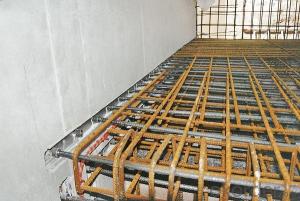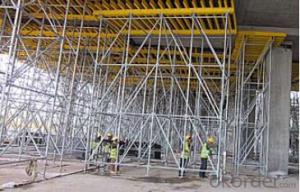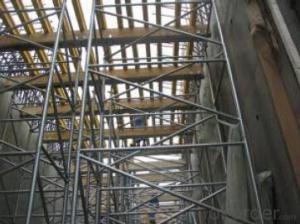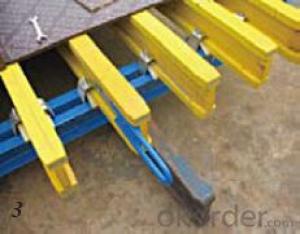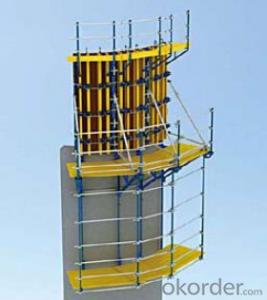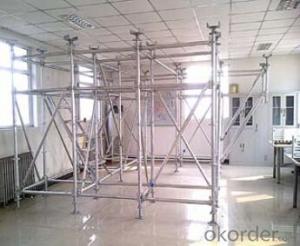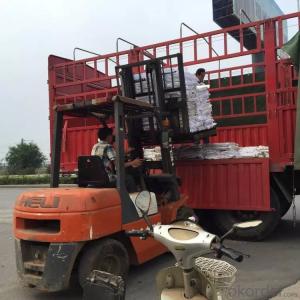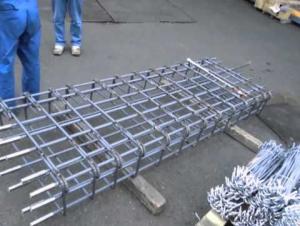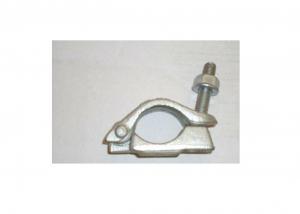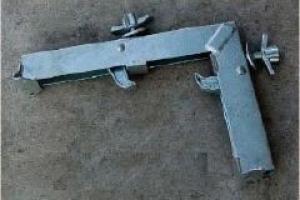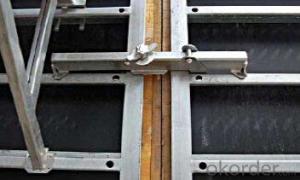Steel Coupler Rebar Pipe Roll For Scaffolding Construction for Wholesales
- Loading Port:
- Shanghai
- Payment Terms:
- TT OR LC
- Min Order Qty:
- 1000 pc
- Supply Capability:
- 10000000 pc/month
OKorder Service Pledge
OKorder Financial Service
You Might Also Like
Steel Coupler Rebar Pipe Roll For Scaffolding Construction for Wholesales
1.Description:
Lapped joints are not always an appropriate means of connecting rebar. The use of Steel Rebar Couplers can simplify the design and construction of reinforced concrete and reduce the amount of reinforcement required.
The threaded steel coupler system is designed as a threaded reinforcement connection with 100% load transmission. The steel coupler rebar connection system is suitable for both static and dynamic load transmission in construction joints.
The coupler is designed as a threaded reinforcement connection for formed construction joints. Reinforcement work is normally carried out on both sides of the construction joint using lap joints or one side is anchored. The bar lengths are based on the structural analysis requirements of the building component and are calculated from anchorage and lap lengths.
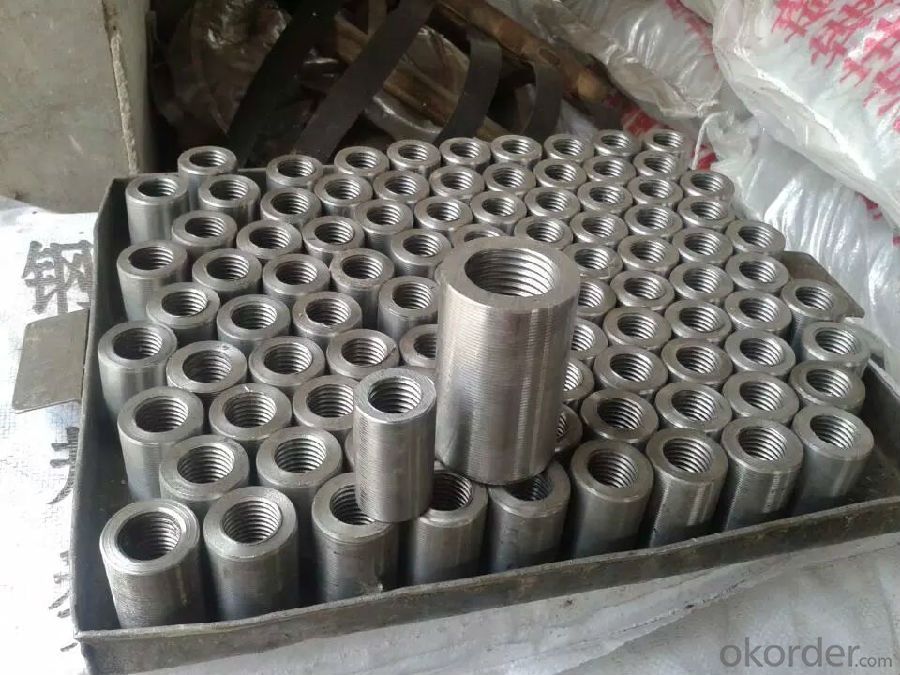

2.Advantages of Steel Coupler Rebar Lift Scaffolding Galvanized Scaffolding Tube with Low Price:
The coupler system provides the opportunity to connect rebars quickly, easily and cost effectively, even when large rebar diameters are used. This makes the steel coupler rebar range a logical extension to our rebendable CNBM reinforcement continuity system for rebars over 12 mm.
3.Available sizes of Steel Coupler Rebar Lift Scaffolding Galvanized Scaffolding Tube with Low Price:
14mm,16mm,18mm,20mm,22mmm,25mm,28mm,32mm,36mm,40mm
4.Delivery:
Delivery Term: FOB / CFR / CIF available.
Delivery Time: 15 days or less after order confirmed.
5.Why choose us?
Technical Expertise
Experienced Management
Stringent Quality Control
Exemplary Service
On-Time Delivery
Wide Product Range
Competitive Pricing
Huge branch network capable of catering worldwide
- Q: What are the different types of reinforcement used in steel formwork systems?
- Steel formwork systems utilize various types of reinforcement to enhance the structural integrity and durability of concrete structures, each serving a specific purpose. 1. Rebars, also known as steel bars, are commonly employed in steel formwork systems to provide tensile strength to the concrete. These bars are positioned in the formwork prior to pouring the concrete, effectively preventing cracking and ensuring structural stability. 2. Wire mesh reinforcement, consisting of interconnected steel wires welded or woven together, is another frequently used type in steel formwork systems. Its purpose is to evenly distribute loads across the concrete, thereby improving its strength and reducing the risk of cracking. 3. Steel fibers, discrete reinforcing elements, are often incorporated directly into the concrete mix. These fibers enhance the concrete's tensile strength, making it more resistant to cracking and enhancing overall durability. Steel fibers are especially valuable in scenarios where traditional reinforcement methods may be challenging to implement. 4. Stirrups and ties, made of steel bars, are commonly employed in reinforced concrete structures and are also integrated into steel formwork systems. They secure the main reinforcement bars in place and provide additional support to the structure. Stirrups and ties prevent rebars from shifting or bending during concrete placement, ensuring proper alignment and spacing. 5. Steel plates and brackets are utilized in formwork systems to bolster support and stability. These elements are typically affixed to the formwork panels, acting as reinforcement mechanisms that distribute loads and prevent deformation or failure. Collectively, the various types of reinforcement used in steel formwork systems play a crucial role in guaranteeing the strength, stability, and longevity of concrete structures. They work in unison to withstand external forces, prevent cracking, and enhance overall structural performance.
- Q: How does steel formwork affect the overall construction waste management?
- Steel formwork is renowned for its durability and reusability, which can have a significant positive impact on construction waste management. Firstly, the multiple reuse of steel formwork reduces the necessity for new formwork materials for each construction project, thus decreasing waste production during construction and lessening the demand for raw materials like timber, commonly utilized in traditional formwork systems. Furthermore, the high strength and stability of steel formwork enable efficient and precise construction, thereby minimizing the occurrence of errors or mistakes during the construction process. This results in reduced rework and waste. Moreover, steel formwork offers easy dismantling and reassembly, allowing for design and construction flexibility and minimizing waste that would otherwise be generated by fixed or permanent formwork systems. Additionally, at the end of its life cycle, steel formwork is recyclable. Steel is widely recognized as one of the most recycled materials globally, and its recycling process is energy-efficient with minimal environmental impact. By opting for steel formwork, construction projects can contribute to a circular economy, ensuring that construction materials can be recycled and reused rather than being disposed of in landfills. To conclude, steel formwork positively impacts construction waste management by reducing waste generation during construction, minimizing the need for new materials, facilitating efficient construction processes, and promoting recycling at the end of its life cycle. These advantages make steel formwork a sustainable choice for construction projects that aim to minimize environmental impact and adopt responsible waste management practices.
- Q: How does steel formwork compare to plastic formwork?
- Construction projects commonly utilize two types of formwork systems: steel formwork and plastic formwork. These systems possess distinct advantages and disadvantages, making them suitable for varying applications. Steel formwork is renowned for its durability and strength, enabling it to withstand heavy loads. Consequently, it is ideal for large-scale projects that necessitate repetitive formwork usage. Compared to plastic formwork, steel formwork boasts a lengthier lifespan, rendering it a cost-effective choice in the long term. It can be effortlessly tailored to meet specific project requirements, thereby permitting design flexibility. Moreover, steel formwork yields a smooth concrete surface finish, reducing the need for supplementary finishing work. Conversely, plastic formwork surpasses steel formwork in several aspects. Its lightweight nature facilitates easy handling and transportation, leading to expedited installation and dismantling times, thereby enhancing overall project efficiency. Plastic formwork is also corrosion-resistant and does not necessitate surface treatment or maintenance. Being reusable and recyclable, it embodies an environmentally friendly option. Furthermore, it possesses commendable insulation properties, thereby facilitating energy consumption reduction in buildings. Regarding cost, steel formwork generally incurs higher upfront expenses due to elevated material and manufacturing costs. Nevertheless, the prolonged lifespan and reusability of steel formwork offset the initial expenditure, rendering it a cost-effective decision for projects involving substantial concrete pouring. In conclusion, the selection between steel formwork and plastic formwork hinges upon specific project requisites. Steel formwork proves suitable for large-scale ventures necessitating durability and strength, whereas plastic formwork is more apt for smaller projects mandating swift installation and dismantling. Both alternatives possess their own merits and demerits, necessitating careful consideration of factors such as cost, project timeline, and design flexibility when arriving at a decision.
- Q: How does steel formwork affect the overall construction site logistics?
- Steel formwork can significantly impact the overall construction site logistics in a positive way. Its durability and reusability allow for faster and more efficient construction processes, reducing the need for frequent replacements. Additionally, the modular nature of steel formwork enables easy assembly and dismantling, saving time and labor costs. This type of formwork also provides precise and consistent results, ensuring higher quality construction. Overall, the use of steel formwork enhances productivity, streamlines logistics, and contributes to smoother operations at the construction site.
- Q: How does steel formwork handle concrete surface finishing?
- Steel formwork is a popular choice in the construction industry due to its durability, strength, and versatility. When it comes to concrete surface finishing, steel formwork offers several advantages. Firstly, steel formwork provides a smooth and even surface, resulting in a high-quality finish. The rigid nature of steel helps prevent any warping or bending during the pouring and curing process, ensuring that the concrete maintains its desired shape and dimensions. This is particularly important for achieving a level and flat surface, which is essential for many construction applications. Additionally, steel formwork allows for precise control over the concrete pouring process. The tight joints and strong connections in steel formwork prevent any leakage or seepage of the concrete, resulting in a clean and consistent surface finish. This is especially beneficial when working on projects that require a high degree of precision or have specific architectural requirements. Furthermore, steel formwork can be easily customized to create various surface finishes. By incorporating different textures, patterns, or coatings onto the steel panels, contractors can achieve a wide range of aesthetic effects on the concrete surface. This flexibility allows for creativity in design and enhances the overall visual appeal of the finished structure. Lastly, steel formwork is reusable, making it a cost-effective solution for concrete surface finishing. Unlike other types of formwork, such as wood or plastic, steel formwork can be cleaned, repaired, and reused multiple times, reducing material waste and saving on construction costs. This sustainability aspect is becoming increasingly important in the construction industry, as it contributes to a more environmentally friendly and economically viable approach. In conclusion, steel formwork provides excellent support for concrete surface finishing. Its strength, precision, customization options, and reusability make it a preferred choice for achieving high-quality finishes in construction projects. Whether it is a smooth and level surface or an intricately textured design, steel formwork ensures that the concrete surface is finished to the desired specifications.
- Q: Can steel formwork be used for both residential and infrastructure projects?
- Yes, steel formwork can be used for both residential and infrastructure projects. Steel formwork offers numerous advantages such as high strength, durability, and reusability, making it suitable for a wide range of construction applications. In residential projects, steel formwork can be utilized for building foundations, walls, slabs, and columns, providing a robust and efficient solution. Similarly, in infrastructure projects, steel formwork can be employed for constructing bridges, tunnels, highways, and other large-scale structures. Its versatility allows for customization to meet specific project requirements and can withstand heavy loads and adverse weather conditions. Furthermore, steel formwork's ability to be easily assembled, disassembled, and reused makes it a cost-effective option for both types of projects. Overall, steel formwork is a highly adaptable and practical choice for various construction purposes, making it suitable for both residential and infrastructure projects.
- Q: How does steel formwork affect the overall aesthetics of the structure?
- The overall appearance of a structure can be greatly influenced by the use of steel formwork. Its smooth and sleek surface finish gives a clean and contemporary look, which is highly desired in modern architectural designs. The precision and accuracy of steel formwork also allow for the creation of intricate details and complex shapes, enhancing the visual appeal of the structure. In addition, steel formwork allows for the creation of sharp edges and precise lines, resulting in a more refined and sophisticated appearance. This is especially advantageous for structures with exposed concrete surfaces, as the use of steel formwork eliminates the need for additional surface treatments or finishing materials. Furthermore, steel formwork provides versatility in terms of creating different textures and patterns on the concrete surface. Architects and designers can enhance the visual impact of the structure and create unique aesthetic effects by utilizing various surface treatments or coatings, such as acid etching or powder coating. Moreover, steel formwork is known for its durability and structural integrity, ensuring that the aesthetics of the structure remain intact over time. Unlike other types of formwork, steel formwork does not warp or deform, providing a consistent and uniform appearance throughout the construction process and beyond. In conclusion, steel formwork has a positive impact on the overall aesthetics of a structure by providing a sleek and modern finish, allowing for intricate detailing and complex shapes, creating sharp edges and precise lines, offering versatility in texture and pattern, and ensuring long-lasting durability.
- Q: Can steel formwork be used for precast concrete walls?
- Yes, steel formwork can be used for precast concrete walls. Steel formwork is a commonly used material in the construction industry due to its strength, durability, and reusability. It provides a solid and stable framework for pouring and shaping concrete during the precast concrete wall manufacturing process. Steel formwork is suitable for precast concrete walls because it can withstand the pressure exerted by the wet concrete without bending or deforming. It ensures that the concrete is poured and set in the desired shape and dimensions. Moreover, steel formwork can be easily assembled and disassembled, allowing for efficient and cost-effective production of precast concrete walls. Another advantage of using steel formwork for precast concrete walls is its ability to produce smooth finishes. The steel panels or molds can be designed to create different textures and patterns on the finished wall surface. This flexibility allows for more design options and aesthetic appeal in the final product. Furthermore, steel formwork can be reused multiple times, making it an environmentally friendly and cost-effective choice for precast concrete wall production. The durability of steel ensures that it can withstand the repetitive stresses of the manufacturing process without significant wear and tear. In summary, steel formwork is a suitable material for precast concrete walls due to its strength, durability, reusability, and ability to produce smooth finishes. It provides a solid framework for shaping and pouring concrete, allowing for efficient and cost-effective production of precast concrete walls.
- Q: How does steel formwork affect the overall construction site productivity?
- The overall productivity of a construction site can be significantly influenced by the use of steel formwork. One of the main advantages of steel formwork is its durability and strength, which allows for multiple reuses on various construction projects. This reusability factor reduces the time and resources needed for formwork installation, thereby increasing the productivity of the construction site. In addition, steel formwork offers better accuracy and precision in shaping concrete structures compared to traditional wooden formwork. The standardized dimensions and design of steel formwork ensure consistent and uniform results, minimizing the need for adjustments or corrections during the construction process. This leads to faster and more efficient construction, saving time and improving productivity. Furthermore, steel formwork is easy to assemble and disassemble, enabling quick and efficient formwork installation and removal. This reduces the idle time of workers and equipment, maximizing resource utilization and increasing productivity on the construction site. Moreover, steel formwork provides excellent strength and stability, allowing for higher concrete pouring rates and reducing the risk of formwork failure. This allows construction teams to work at a faster pace, pouring larger volumes of concrete in a shorter period, ultimately enhancing overall productivity. Lastly, steel formwork is highly resistant to adverse weather conditions and can withstand harsh environments. This durability ensures that construction activities can continue without interruptions caused by bad weather, leading to improved site productivity. In conclusion, the use of steel formwork positively impacts construction site productivity by offering durability, reusability, accuracy, ease of assembly, and resistance to weather conditions. These factors contribute to faster construction, reduced downtime, and optimized resource utilization, ultimately enhancing overall productivity on the construction site.
- Q: What are the typical sheet thicknesses used in steel formwork panels?
- The typical sheet thicknesses used in steel formwork panels can vary depending on the specific application and requirements. However, commonly used sheet thicknesses range from 6mm to 12mm. Thicker sheets are usually preferred for heavy-duty applications or when higher load-bearing capacities are needed. On the other hand, thinner sheets can be used for lighter applications or when weight reduction is a priority. It is important to consider factors such as the size of the formwork panel, the desired strength and durability, and the anticipated loads when determining the appropriate sheet thickness for steel formwork panels.
Send your message to us
Steel Coupler Rebar Pipe Roll For Scaffolding Construction for Wholesales
- Loading Port:
- Shanghai
- Payment Terms:
- TT OR LC
- Min Order Qty:
- 1000 pc
- Supply Capability:
- 10000000 pc/month
OKorder Service Pledge
OKorder Financial Service
Similar products
Hot products
Hot Searches
Related keywords
